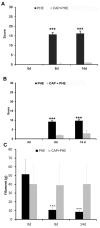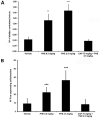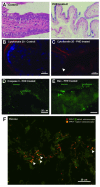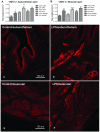Can the adrenergic system be implicated in the pathophysiology of bladder pain syndrome/interstitial cystitis? A clinical and experimental study
- PMID: 24375689
- PMCID: PMC4069202
- DOI: 10.1002/nau.22542
Can the adrenergic system be implicated in the pathophysiology of bladder pain syndrome/interstitial cystitis? A clinical and experimental study
Abstract
Aims: To evaluate sympathetic system activity in bladder pain syndrome/interstitial cystitis (BPS/IC) patients and to investigate if chronic adrenergic stimulation in intact rats induces BPS/IC-like bladder modifications.
Methods: Clinical study--In BPS/IC patients and aged and body mass index matched volunteers TILT test was undertaken and catecholamines were measured in plasma and 24 hr urine samples. Experimental study--Phenylephrine was injected subcutaneously (14 days) to female Wistar rats. Pain behavior, spinal Fos expression, urinary spotting, number of fecal pellets expelled, frequency of reflex bladder contractions, and urothelial height were analyzed. Urothelium permeability was investigated by trypan blue staining. Immunoreactivity against caspase 3 and bax were studied in the urothelium and against alpha-1-adrenoreceptor and TRPV1 in suburothelial nerves. Mast cell number was determined in the sub-urothelium. In rats with lipopolysaccharide-induced cystitis, urinary catecholamines, and Vesicular Monoamine Transporter 2 (VMAT2) expression in bladder nerves were analyzed.
Results: The TILT test showed an increase of sympathetic activity. Noradrenaline levels in blood at resting conditions and in 24-hr urine samples were higher in BPS/IC patients. Phenylephrine administration increased visceral pain, spinal Fos expression, bladder reflex activity, urinary spotting and the number of expelled fecal pellets. The mucosa showed urothelial thinning and increased immunoreactivity for caspase 3 and bax. Trypan blue staining was only observed in phenylephrine treated animals. Suburothelial nerves co-expressed alpha1 and TRPV1. Mastocytosis was present in the suburothelium. Cystitis increased sympathetic nerve density and urinary noradrenaline levels.
Conclusions: Excessive adrenergic stimulation of the bladder may contribute to the pathophysiological mechanisms of BPS/IC.
Keywords: bladder pain syndrome/interstitial cystitis; primary afferents; sympathetic system; urothelium.
© 2013 Wiley Periodicals, Inc.
Figures




Similar articles
-
Histamine induces peripheral and central hypersensitivity to bladder distension via the histamine H1 receptor and TRPV1.Am J Physiol Renal Physiol. 2020 Feb 1;318(2):F298-F314. doi: 10.1152/ajprenal.00435.2019. Epub 2019 Dec 2. Am J Physiol Renal Physiol. 2020. PMID: 31790304
-
Sensory Receptor, Inflammatory, and Apoptotic Protein Expression in the Bladder Urothelium of Patients with Different Subtypes of Interstitial Cystitis/Bladder Pain Syndrome.Int J Mol Sci. 2023 Jan 3;24(1):820. doi: 10.3390/ijms24010820. Int J Mol Sci. 2023. PMID: 36614264 Free PMC article.
-
Bladder pain induced by prolonged peripheral alpha 1A adrenoceptor stimulation involves the enhancement of transient receptor potential vanilloid 1 activity and an increase of urothelial adenosine triphosphate release.Acta Physiol (Oxf). 2016 Dec;218(4):265-275. doi: 10.1111/apha.12744. Epub 2016 Jul 20. Acta Physiol (Oxf). 2016. PMID: 27370818
-
Beyond the urothelium: Interplay between autonomic nervous system and bladder inflammation in urinary tract infection, bladder pain syndrome with interstitial cystitis and neurogenic lower urinary tract dysfunction in spinal cord injury-ICI-RS 2023.Neurourol Urodyn. 2024 Aug;43(6):1283-1292. doi: 10.1002/nau.25310. Epub 2023 Oct 25. Neurourol Urodyn. 2024. PMID: 37876314 Review.
-
Urinary bladder, cystitis and nerve/urothelial interactions.Auton Neurosci. 2014 May;182:89-94. doi: 10.1016/j.autneu.2013.12.005. Epub 2013 Dec 25. Auton Neurosci. 2014. PMID: 24412640 Free PMC article. Review.
Cited by
-
Sympathetic nervous system and chronic bladder pain: a new tune for an old song.Transl Androl Urol. 2015 Oct;4(5):534-42. doi: 10.3978/j.issn.2223-4683.2015.09.06. Transl Androl Urol. 2015. PMID: 26816852 Free PMC article. Review.
-
Silodosin Improves Pain and Urinary Frequency in Bladder Pain Syndrome/Interstitial Cystitis Patients.J Clin Med. 2022 Sep 26;11(19):5659. doi: 10.3390/jcm11195659. J Clin Med. 2022. PMID: 36233527 Free PMC article.
-
Stress-induced autonomic dysregulation of mitochondrial function in the rat urothelium.Neurourol Urodyn. 2019 Feb;38(2):572-581. doi: 10.1002/nau.23876. Epub 2018 Dec 21. Neurourol Urodyn. 2019. PMID: 30575113 Free PMC article.
-
Effects of the Fourth Ventricle Compression in the Regulation of the Autonomic Nervous System: A Randomized Control Trial.Evid Based Complement Alternat Med. 2015;2015:148285. doi: 10.1155/2015/148285. Epub 2015 Jun 14. Evid Based Complement Alternat Med. 2015. PMID: 26199632 Free PMC article.
-
From bladder to systemic syndrome: concept and treatment evolution of interstitial cystitis.Int J Womens Health. 2015 Jul 23;7:735-44. doi: 10.2147/IJWH.S60798. eCollection 2015. Int J Womens Health. 2015. PMID: 26229509 Free PMC article. Review.
References
-
- Tripp DA, Nickel JC, Wong J, et al. Mapping of pain phenotypes in female patients with bladder pain syndrome/interstitial cystitis and controls. Eur Urol. 2012;62:1188. - PubMed
Publication types
MeSH terms
Substances
Grants and funding
LinkOut - more resources
Full Text Sources
Other Literature Sources
Medical
Research Materials

